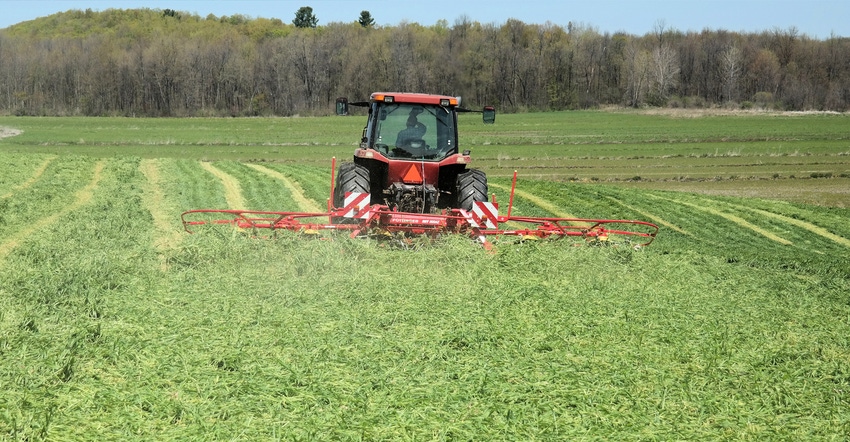
The key to triticale quality is harvest timing, emphasizes Tom Kilcer, certified crop advisor for Advanced Ag Systems at Kinderhook, N.Y. "Stage 9 (flag leaf emergence) is when you have very high milk per ton feed value plus excellent yields (8 to 12 tons of silage per acre). If you miss it and get early boot (stage 10), it's still very good — 20% to 30% higher yields, and good feed for lower producers."
This spring's slow-to-warm temperatures may have been a blessing in that sense. Forage plant maturation slows when temperatures drop below 40 degrees F. That gives you more time to harvest peak quality. After peaking, quality still continues down, but at a slower rate.
Hopefully you'll get a day or two of sunshine before harvest for photosynthesis to produce enough substrate for fermentation and high energy for milk production, Kilcer adds.
Bring on wide-swathing and tedding
To dry for same-day triticale silage, you'll need to wide-swath (a swath width greater than 80% of cutterbar) and use a tedder at least once. Increasing the length of cut to 1 inch dramatically reduces the leachate from the silos. It also provides more effective rumen fiber and better digestion for this rapidly digestible product.
As with brown mid-rib sorghums, adding a quality straight homolactic bacterial inoculant drops pH down fast and actually limits off-fermentation by wild bacteria, Kilcer says. Some inoculants are specifically designed for these wet, high-sugar forages and inhibit the tendency to produce clostridia and butyric acid. L. buchneri inoculants are for drier forages.
Why delaying corn planting pays
First-cutting forages wait for no one. "Every analysis made over the last 40 years has come to the same conclusion: Stop planting corn and harvest hay crop," he adds.
Cool-season forages lose quality to the tune of 0.55 pounds of milk per cow per day from declining neutral detergent fiber digestibility. Later-planted corn does not. Corn silage quality and yields are only slightly reduced if planted at the end of May or early June. Corn of optimum maturity makes more milk than longer-season corn that "might" make more tons of wet silage.
The biggest mistake is to "mud it in." Being slightly late is far less costly than the 14% to 27% yield loss from soil compaction.
Source: Advanced Ag Systems
About the Author(s)
You May Also Like




